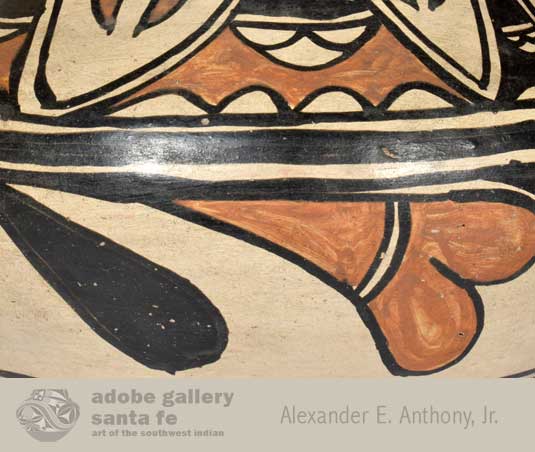Traditional Tewa Polychrome Jar with Exquisite Designs [SOLD]
+ Add to my watchlist Forward to Friend
- Category: Historic
- Origin: San Ildefonso Pueblo, Po-woh-ge-oweenge
- Medium: clay, pigment
- Size: 9-¼” height x 9-¾” diameter
- Item # C4136A SOLD
Martina Vigil Montoya (1856-1916) and Florentino Montoya (1858-1918) were the finest potters at San Ildefonso Pueblo from as early as the 1880s. They were masters at creating magnificent Polychrome jars. Martina had learned pottery making from her mother, Toña Peña Vigil, who also was a very talented potter. Florentino had studied the designs of Toña’s pottery and adapted his style on hers.
Florentino Montoya possessed the artistic talent that permitted him to select the correct treatment for Martina’s jars. He had an inherent talent for visualizing the layout and shapes to perfectly fit the areas on which he was painting. The design he chose for this jar is a perfect fit for the shape of the vessel, both above the midpoint and below the midpoint.
Martina and Florentino were the first potters to bring attention to San Ildefonso as a center of innovative ceramic genius. While potters of other pueblos had succumbed to making insignificant trinkets for the influx of tourists visiting New Mexico on the newly arrived rail service, San Ildefonso was spared this temptation because of its relative isolation. Martina and Florentino proceeded to produce magnificent wares. Their imaginative and inspirational courage was not recognized at the time but they set the stage for the future of pueblo ceramics. Martina passed this experimental quality on to her apprentice, Maria Martinez, who learned enthusiastically. Maria and Julian then carried it forward into the 20th century.
Attributing work to long-deceased artists is always subject to questions, but sometimes the work just seems to fit the hands of certain artists and it is not wrong to speculate that it was made by them. That is the case with this San Ildefonso jar. It has construction and design elements that have been associated with Martina and Florentino.
Martina’s mother was from San Ildefonso and her dad from Cochiti so Martina was expected to share her loyalty to both. She and Florentino traveled to Cochiti on many occasions and it was during these trips that she discovered that the cream slip being used at Cochiti required only rag polishing while that at San Ildefonso required extensive stone polishing. She introduced the Cochiti slip at San Ildefonso before her departure in 1905. This jar appears to have the Cochiti slip, a clue that it dates to post 1905.
One of the design traits recognizable of Florentino’s is the alternating black/red adjacent design elements. It is obvious in the design on this jar. Each adjoining element is alternating in color. Martina’s vessel shape is the very traditional *Tewa olla from the early 1900s. This jar most likely dates to circa 1910.
Condition: this Traditional Tewa Polychrome Jar with Exquisite Designs is in very good condition
Provenance: from the collection of a client from Texas
Recommended Reading: Batkin, Jonathan. Martina Vigil and Florentino Montoya: Master Potters of San Ildefonso and Cochiti Pueblos. American Indian Art Magazine, Autumn 1987.
*Tewa or Tano: one of three Kiowa-Tanoan languages spoken by the Pueblo people of New Mexico. Though these three languages are closely related, speakers of one cannot fully understand speakers of another. The six Tewa-speaking pueblos are Nambe, Pojoaque, San Ildefonso, San Juan, Santa Clara, and Tesuque.

- Category: Historic
- Origin: San Ildefonso Pueblo, Po-woh-ge-oweenge
- Medium: clay, pigment
- Size: 9-¼” height x 9-¾” diameter
- Item # C4136A SOLD



